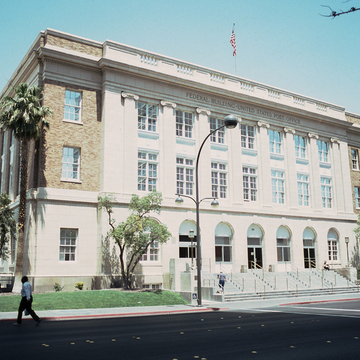You are here
The Mob Museum
The post office, on a strip of land called the Civic Center, seems out of place across the street from casino parking garages. When built, the three-story, steel-frame building in the Beaux-Arts classical style, designed by the Office of the Supervising Architect of the U.S. Treasury Department, was the most elaborate in Las Vegas, signifying its important role as the home of the main post office, federal courts, and other federal agencies. Central steps lead to the first story, containing a series of arched openings with doors and windows, flanked by massive end bays clad in brick on the two upper floors. A central bay projects slightly over the main entrance, covered entirely by creamy white terra-cotta tiles. Above the arches of the entranceway, eight Ionic pilasters separate vertical stacks of windows. Terra-cotta tiles also clad the first floor of the building on the sides and rear, as on the front.
The choice of Beaux-Arts classicism reflects the taste of the Treasury Department's supervising architects of the 1890s and early 1900s; in the 1930s this style would give way to the far simpler PWA Moderne. As in other small Nevada towns during the Great Depression, this building signified an increased federal presence, contrasting dramatically with the bars and hotels surrounding it.
In 2001, the City of Las Vegas assumed ownership of the building with the stipulation that it be used for a cultural purpose. The post office vacated the structure in 2005. Then mayor Oscar Goodman, a former criminal defense attorney who had represented members of the Mafia, proposed transforming the building into a history museum devoted to organized crime and law enforcement. Funded by a combination of local, state, and federal grants, Westlake Reed Leskosky (now part of DLR Group) renovated the structure to include 20,000 feet of exhibition space. The focal point of the building is the restored second-floor courtroom where U.S. Senator Estes Kefauver held hearings to expose organized crime in 1950-1951. The interactive exhibits, films, and high-tech audio visual displays were designed by Dennis and Kathy Barrie, and present the history of organized crime in the country, particularly its presence in Las Vegas. The museum has rapidly become a popular tourist destination and has been a catalyst in the redevelopment of the downtown area.
References
"Building and Kefauver Story." The Mob Museum. Accessed January 22, 2020. https://themobmuseum.org/
Friess, Steve. "Stimulus Money for a Mob Museum. Got a Problem?" New York Times, January 9, 2009.
"The Mob Museum." DLR Group. Accessed January 22, 2020. https://www.dlrgroup.com/.
Writing Credits
If SAH Archipedia has been useful to you, please consider supporting it.
SAH Archipedia tells the story of the United States through its buildings, landscapes, and cities. This freely available resource empowers the public with authoritative knowledge that deepens their understanding and appreciation of the built environment. But the Society of Architectural Historians, which created SAH Archipedia with University of Virginia Press, needs your support to maintain the high-caliber research, writing, photography, cartography, editing, design, and programming that make SAH Archipedia a trusted online resource available to all who value the history of place, heritage tourism, and learning.

